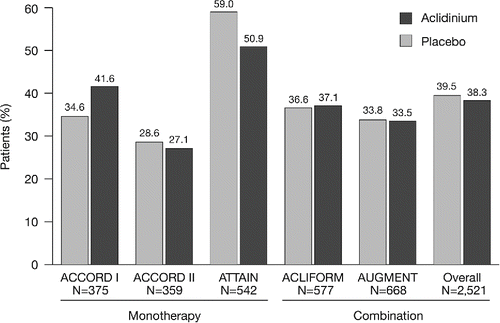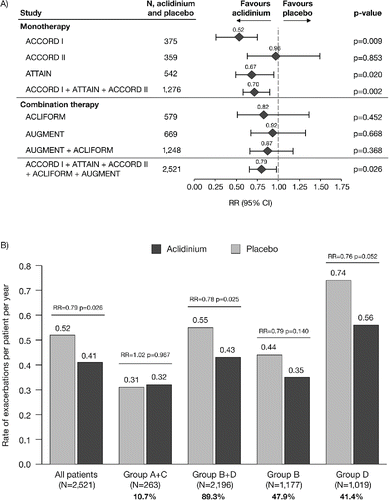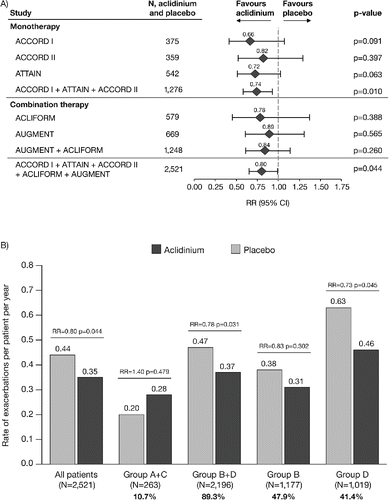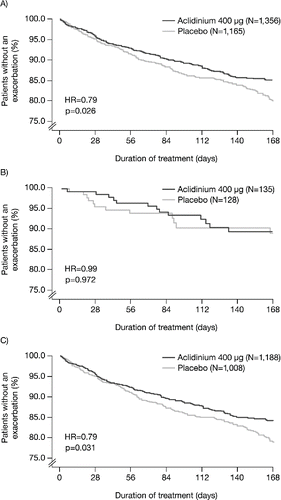Figures & data
Table 1. Study designs.
Table 2. Patient demographics and baseline characteristics (ITT population).
Figure 1. Pooled analysis population, stratified by GOLD group (ITT population). aPatients had FEV1 30–80% predicted. There were 62 patients with insufficient data for GOLD classification. ITT, intent-to-treat; GOLD, Global initiative for chronic Obstructive Lung Disease; N, number of patients in aclidinium 400 μg and placebo groups.

Figure 2. Concomitant ICS use by study and overall (ITT population). ICS, inhaled corticosteroid; ITT, intent-to-treat; N, number of patients in aclidinium 400 μg and placebo groups.

Table 3. Patients with ≥1 exacerbation.
Figure 3. Rate of COPD exacerbations of any severity (A) overall (individual studies and pooled analyses)a and (B) stratified by GOLD group (pooled analysis). aExacerbations analyses from the individual ACLIFORM and AUGMENT studies are reported for the ITT-exacerbations populations of the aclidinium monotherapy and placebo arms only (579 and 669 patients, respectively; all patients who received at least one dose of the study medication), as specified in the study protocols and published previously (Citation20,32); pooled analyses include data from the ITT populations (577 and 668 patients, respectively; all patients who received at least one dose of the study medication and had a baseline and ≥1 post-baseline FEV1 assessment) for consistency with the ACCORD I, ACCORD II and ATTAIN study populations. Percentages are the proportion of all GOLD-classified patients (N = 2,459) in each GOLD group. CI, confidence interval; COPD, chronic obstructive pulmonary disease; GOLD, Global initiative for chronic Obstructive Lung Disease; ITT, intent-to-treat; RR, rate ratio; N, number of patients in aclidinium 400 μg and placebo groups.

Figure 4. Rate of moderate-to-severe COPD exacerbations (A) overall (individual studies and pooled analyses)a and (B) stratified by GOLD group (pooled analysis). aExacerbations analyses from the individual ACLIFORM and AUGMENT studies are reported for the ITT-exacerbations populations of the aclidinium monotherapy and placebo arms only (579 and 669 patients, respectively; all patients who received at least one dose of the study medication), as specified in the study protocols and published previously (Citation20,32); pooled analyses include data from the ITT populations (577 and 668 patients, respectively; all patients who received at least one dose of the study medication and had a baseline and ≥1 post-baseline FEV1 assessment) for consistency with the ACCORD I, ACCORD II and ATTAIN study populations. Percentages are the proportion of all GOLD-classified patients (N = 2,459) in each GOLD group. CI, confidence interval; GOLD, Global initiative for chronic Obstructive Lung Disease; ITT, intent-to-treat; RR, rate ratio; N, number of patients in aclidinium 400 μg and placebo groups.

Table 4. Exacerbation rates stratified by concomitant ICS use (ITT population).
Figure 5. Time to first COPD exacerbation of any severity in (A) all patients; (B) patients in GOLD Groups A and C; and (C) patients in GOLD Groups B and D (ITT population). COPD, chronic obstructive pulmonary disease; GOLD, Global initiative for chronic Obstructive Lung Disease; HR, hazard ratio; ITT, intent-to-treat; N, number of patients.

